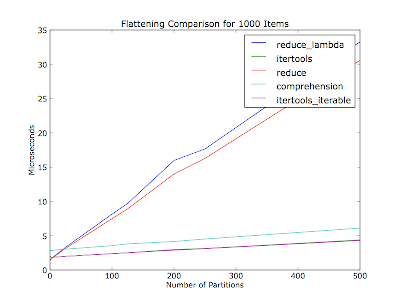你试过扁平化吗?来自matplotlib.cbook.flatten(seq, scalarp=)?
l=[[1,2,3],[4,5,6], [7], [8,9]]*33
run("list(flatten(l))")
3732 function calls (3303 primitive calls) in 0.007 seconds
Ordered by: standard name
ncalls tottime percall cumtime percall filename:lineno(function)
1 0.000 0.000 0.007 0.007 <string>:1(<module>)
429 0.001 0.000 0.001 0.000 cbook.py:475(iterable)
429 0.002 0.000 0.003 0.000 cbook.py:484(is_string_like)
429 0.002 0.000 0.006 0.000 cbook.py:565(is_scalar_or_string)
727/298 0.001 0.000 0.007 0.000 cbook.py:605(flatten)
429 0.000 0.000 0.001 0.000 core.py:5641(isMaskedArray)
858 0.001 0.000 0.001 0.000 {isinstance}
429 0.000 0.000 0.000 0.000 {iter}
1 0.000 0.000 0.000 0.000 {method 'disable' of '_lsprof.Profiler' objects}
l=[[1,2,3],[4,5,6], [7], [8,9]]*66
run("list(flatten(l))")
7461 function calls (6603 primitive calls) in 0.007 seconds
Ordered by: standard name
ncalls tottime percall cumtime percall filename:lineno(function)
1 0.000 0.000 0.007 0.007 <string>:1(<module>)
858 0.001 0.000 0.001 0.000 cbook.py:475(iterable)
858 0.002 0.000 0.003 0.000 cbook.py:484(is_string_like)
858 0.002 0.000 0.006 0.000 cbook.py:565(is_scalar_or_string)
1453/595 0.001 0.000 0.007 0.000 cbook.py:605(flatten)
858 0.000 0.000 0.001 0.000 core.py:5641(isMaskedArray)
1716 0.001 0.000 0.001 0.000 {isinstance}
858 0.000 0.000 0.000 0.000 {iter}
1 0.000 0.000 0.000 0.000 {method 'disable' of '_lsprof.Profiler' objects}
l=[[1,2,3],[4,5,6], [7], [8,9]]*99
run("list(flatten(l))")
11190 function calls (9903 primitive calls) in 0.010 seconds
Ordered by: standard name
ncalls tottime percall cumtime percall filename:lineno(function)
1 0.000 0.000 0.010 0.010 <string>:1(<module>)
1287 0.002 0.000 0.002 0.000 cbook.py:475(iterable)
1287 0.003 0.000 0.004 0.000 cbook.py:484(is_string_like)
1287 0.002 0.000 0.009 0.000 cbook.py:565(is_scalar_or_string)
2179/892 0.001 0.000 0.010 0.000 cbook.py:605(flatten)
1287 0.001 0.000 0.001 0.000 core.py:5641(isMaskedArray)
2574 0.001 0.000 0.001 0.000 {isinstance}
1287 0.000 0.000 0.000 0.000 {iter}
1 0.000 0.000 0.000 0.000 {method 'disable' of '_lsprof.Profiler' objects}
l=[[1,2,3],[4,5,6], [7], [8,9]]*132
run("list(flatten(l))")
14919 function calls (13203 primitive calls) in 0.013 seconds
Ordered by: standard name
ncalls tottime percall cumtime percall filename:lineno(function)
1 0.000 0.000 0.013 0.013 <string>:1(<module>)
1716 0.002 0.000 0.002 0.000 cbook.py:475(iterable)
1716 0.004 0.000 0.006 0.000 cbook.py:484(is_string_like)
1716 0.003 0.000 0.011 0.000 cbook.py:565(is_scalar_or_string)
2905/1189 0.002 0.000 0.013 0.000 cbook.py:605(flatten)
1716 0.001 0.000 0.001 0.000 core.py:5641(isMaskedArray)
3432 0.001 0.000 0.001 0.000 {isinstance}
1716 0.001 0.000 0.001 0.000 {iter}
1 0.000 0.000 0.000 0.000 {method 'disable' of '_lsprof.Profiler'
更新
这给了我另一个想法:
l=[[1,2,3],[4,5,6], [7], [8,9]]*33
run("flattenlist(l)")
564 function calls (432 primitive calls) in 0.000 seconds
Ordered by: standard name
ncalls tottime percall cumtime percall filename:lineno(function)
133/1 0.000 0.000 0.000 0.000 <ipython-input-55-39b139bad497>:4(flattenlist)
1 0.000 0.000 0.000 0.000 <string>:1(<module>)
429 0.000 0.000 0.000 0.000 {isinstance}
1 0.000 0.000 0.000 0.000 {method 'disable' of '_lsprof.Profiler' objects}
l=[[1,2,3],[4,5,6], [7], [8,9]]*66
run("flattenlist(l)")
1125 function calls (861 primitive calls) in 0.001 seconds
Ordered by: standard name
ncalls tottime percall cumtime percall filename:lineno(function)
265/1 0.001 0.000 0.001 0.001 <ipython-input-55-39b139bad497>:4(flattenlist)
1 0.000 0.000 0.001 0.001 <string>:1(<module>)
858 0.000 0.000 0.000 0.000 {isinstance}
1 0.000 0.000 0.000 0.000 {method 'disable' of '_lsprof.Profiler' objects}
l=[[1,2,3],[4,5,6], [7], [8,9]]*99
run("flattenlist(l)")
1686 function calls (1290 primitive calls) in 0.001 seconds
Ordered by: standard name
ncalls tottime percall cumtime percall filename:lineno(function)
397/1 0.001 0.000 0.001 0.001 <ipython-input-55-39b139bad497>:4(flattenlist)
1 0.000 0.000 0.001 0.001 <string>:1(<module>)
1287 0.000 0.000 0.000 0.000 {isinstance}
1 0.000 0.000 0.000 0.000 {method 'disable' of '_lsprof.Profiler' objects}
l=[[1,2,3],[4,5,6], [7], [8,9]]*132
run("flattenlist(l)")
2247 function calls (1719 primitive calls) in 0.002 seconds
Ordered by: standard name
ncalls tottime percall cumtime percall filename:lineno(function)
529/1 0.001 0.000 0.002 0.002 <ipython-input-55-39b139bad497>:4(flattenlist)
1 0.000 0.000 0.002 0.002 <string>:1(<module>)
1716 0.001 0.000 0.001 0.000 {isinstance}
1 0.000 0.000 0.000 0.000 {method 'disable' of '_lsprof.Profiler' objects}
l=[[1,2,3],[4,5,6], [7], [8,9]]*1320
run("flattenlist(l)")
22443 function calls (17163 primitive calls) in 0.016 seconds
Ordered by: standard name
ncalls tottime percall cumtime percall filename:lineno(function)
5281/1 0.011 0.000 0.016 0.016 <ipython-input-55-39b139bad497>:4(flattenlist)
1 0.000 0.000 0.016 0.016 <string>:1(<module>)
17160 0.005 0.000 0.005 0.000 {isinstance}
1 0.000 0.000 0.000 0.000 {method 'disable' of '_lsprof.Profiler' objects}
所以要测试当递归变得更深时它的有效性:有多深?
l=[[1,2,3],[4,5,6], [7], [8,9]]*1320
new=[l]*33
run("flattenlist(new)")
740589 function calls (566316 primitive calls) in 0.418 seconds
Ordered by: standard name
ncalls tottime percall cumtime percall filename:lineno(function)
174274/1 0.281 0.000 0.417 0.417 <ipython-input-55-39b139bad497>:4(flattenlist)
1 0.001 0.001 0.418 0.418 <string>:1(<module>)
566313 0.136 0.000 0.136 0.000 {isinstance}
1 0.000 0.000 0.000 0.000 {method 'disable' of '_lsprof.Profiler' objects}
new=[l]*66
run("flattenlist(new)")
1481175 function calls (1132629 primitive calls) in 0.809 seconds
Ordered by: standard name
ncalls tottime percall cumtime percall filename:lineno(function)
348547/1 0.542 0.000 0.807 0.807 <ipython-input-55-39b139bad497>:4(flattenlist)
1 0.002 0.002 0.809 0.809 <string>:1(<module>)
1132626 0.266 0.000 0.266 0.000 {isinstance}
1 0.000 0.000 0.000 0.000 {method 'disable' of '_lsprof.Profiler' objects}
new=[l]*99
run("flattenlist(new)")
2221761 function calls (1698942 primitive calls) in 1.211 seconds
Ordered by: standard name
ncalls tottime percall cumtime percall filename:lineno(function)
522820/1 0.815 0.000 1.208 1.208 <ipython-input-55-39b139bad497>:4(flattenlist)
1 0.002 0.002 1.211 1.211 <string>:1(<module>)
1698939 0.393 0.000 0.393 0.000 {isinstance}
1 0.000 0.000 0.000 0.000 {method 'disable' of '_lsprof.Profiler' objects}
new=[l]*132
run("flattenlist(new)")
2962347 function calls (2265255 primitive calls) in 1.630 seconds
Ordered by: standard name
ncalls tottime percall cumtime percall filename:lineno(function)
697093/1 1.091 0.000 1.627 1.627 <ipython-input-55-39b139bad497>:4(flattenlist)
1 0.003 0.003 1.630 1.630 <string>:1(<module>)
2265252 0.536 0.000 0.536 0.000 {isinstance}
1 0.000 0.000 0.000 0.000 {method 'disable' of '_lsprof.Profiler' objects}
new=[l]*1320
run("flattenlist(new)")
29623443 function calls (22652523 primitive calls) in 16.103 seconds
Ordered by: standard name
ncalls tottime percall cumtime percall filename:lineno(function)
6970921/1 10.842 0.000 16.069 16.069 <ipython-input-55-39b139bad497>:4(flattenlist)
1 0.034 0.034 16.103 16.103 <string>:1(<module>)
22652520 5.227 0.000 5.227 0.000 {isinstance}
1 0.000 0.000 0.000 0.000 {method 'disable' of '_lsprof.Profiler' objects}
我敢打赌“flattenlist”我将使用它而不是 matploblib 很长一段时间,除非我想要一个产量生成器和快速结果,因为 matploblib.cbook 中的“flatten”使用
这个,很快。
:
typ=(list,tuple)
def flattenlist(d):
thelist = []
for x in d:
if not isinstance(x,typ):
thelist += [x]
else:
thelist += flattenlist(x)
return thelist
